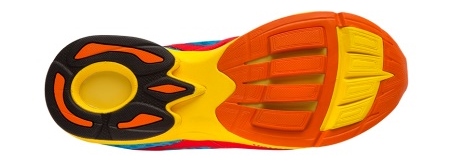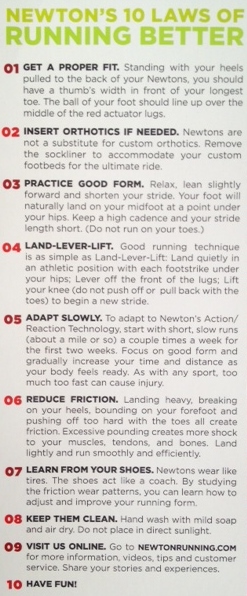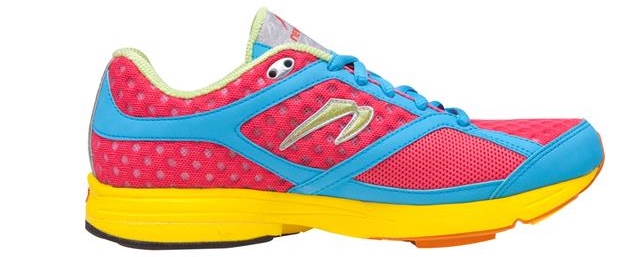I used to say that using technology like “actuator lugs” to promote a neutral, natural foot strike was ironic and totally unnecessary.
Of course, I’m talking about Newton running shoes which have a very distinctive sole:

I refused to wear them because of those wacky lugs and thought they weren’t for “real” runners. But then I thought I should test my assumptions about such a unique shoe and Newton was gracious enough to supply a pair for me to review.
And tested they were!
You see, Newtons all have these lugs on the forefoot that put you in a more neutral position because the heel-toe drop differential is reduced – you’re not standing with an elevated heel like many other shoes on the market. I thought the lugs seemed silly before I ran in them. Now, I’m a fan of the Newton Gravity’s I’ve worn for the last three weeks.
Newton Gravity Running Shoe – Specs and Overview
I wear a size 10 shoe and wore the Gravity’s almost exclusively for three weeks. Admittedly, this was a quick transition to a shoe that claims it promotes a more “natural” running form. Usually, that phrase simply means that the shoes promote a midfoot strike and reduce heel striking (even though heel striking isn’t necessarily bad).
So, why can I make this transition much more quickly than most runners? I had just spent three months running in neutral shoes, wearing flip flops the rest of the time, and I did a lot of barefoot walking.
During the last four weeks I’ve also run once a week in even more minimalist shoes (currently the Brooks PureFlows).
If you’re looking to run in more low-profile shoes, here’s my step-by-step post on how to run in minimalist running shoes.
Anyway, here are the most important Newton Gravity specs:
- 3mm heel-toe drop
- 9.1 ounces
- Anti-microbial sockliner (I still have no problems with smell – just sniffed!)
My first impression was that they felt weird. I wasn’t used to the lugs underneath my forefoot and walking in them was odd. But I ran a tempo during a 14 miler for my first run in them and they felt really good – much different than when walking.
Other than a bit of lower leg soreness afterward, which was to be expected, I liked the feel of the Gravity’s. They’re not a very low-profile shoe and have a significantly raised footbed but I personally prefer a little more cushion. After a few days I got used to the low heel-toe drop and kept running in them 5-6 days per week.
You’ll definitely notice the actuator lugs while running but I quickly adapted and they don’t feel awkward anymore. In fact, I like that they promote a midfoot strike while offering some cushion (typically a rare combination). For me, they work.
I’ve since worn them on 21 mile long runs with three miles on the back half in under six minutes. I had no problems and appreciated the “Action/Reaction” material in the sole that claims to lose less energy than EVA foam, gel, or air. It felt responsive and when I’m feeling good, I can really cruise in the Gravity’s!
One of the small details that I really appreciated was an insert in the shoebox that I took a picture of and included above. There’s some great advice about running form that you don’t get from most of the other major shoe manufacturers.
The best piece of advice: don’t run on your toes. Unless you’re sprinting, an aggressive forefoot strike is probably worse than an aggressive heel strike!
Pros and Cons of the Newton Gravity

No shoe is perfect and I want to be clear that while I really liked the Gravity’s, I won’t be purchasing a pair for future training. I’ll stick to some of the other running shoes I’ve reviewed. But before I get into that, I want to go over their pros and cons the way I see them.
Pros
- Cushioned, neutral trainer with a light, responsive ride
- Promotes a midfoot strike without forcing you to make noticeable form changes
- 3mm heel-toe drop (just remember to transition slower than I did!)
- Comfortable upper – no problems with blisters
- Durable – low wear and tear even after 200+ miles
Cons
- Price – at $175 they’re inaccessible for most of the market. I don’t think they’re worth it.
- Debris can get stuck in the actuator lugs, especially if you run a lot of trails
- Could be too cushioned for some runners
I recommend the Newton Gravity running shoes for runners with a neutral foot strike or those who are mild overpronators who want a “cautious minimalist” shoe.
They may not be great for trail running (rocks and sticks get stuck in the lugs) or racing (they’re too high-profile for my tastes), but as a neutral trainer that can promote more lower leg strength, they’re a valuable tool in any runner’s toolbox.
The reason why I won’t be purchasing a pair is simply because of the price tag. They’re about double what most running shoes cost and I just can’t figure out why they’re priced at $175. I’m sure it has to do with the actuator lugs and proprietary sole material but regardless, it’s out of my reach and I suspect that’s true for most runners.
But as I continue to run in the Gravity’s, I have to admit that my first impression of them was wrong. The lugs do promote a neutral running stride without being overly obtrusive. I wouldn’t go walking in them or wear them casually, but for running they’re a comfortable addition to my collection of running shoes.
If you want to give them a try, the best deal seems to be on Amazon where they qualify for free shipping. Check them out here.